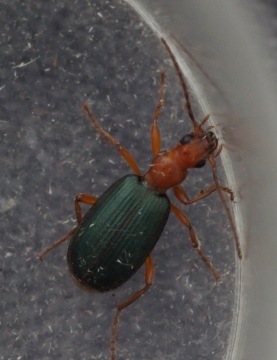Species Account for Brachinus crepitans
PLEASE NOTE, many records in this group are not yet available
Brachinus crepitans (Linnaeus, 1758)
Bombardier Beetle
Coleoptera: Carabidae

Reproduction for study and non-profit use permitted, all other rights reserved.
Taxonomic group: beetles (Coleoptera) - Available county data
View time series maps for Brachinus crepitans
member log-on for taxon report
Status: NS
Essex RDB: Listed
Images
upload a new image
Essex Red Data List comment
Essex Post-1969 record/s
Species text
The Bombardier Beetle Brachinus crepitans is widespread but local in southern and eastern England and into South Wales. Most recent records are coastal (Luff 1998). It occurs in short, dry grassland, usually on chalk or limestone, and also clay brick-pits, undercliffs, sea walls and stabilised shingle on the coast. Adults have been found under stones and leaf rosettes, as well as under grass mats growing on concrete blocks on the seaward side of sea walls. Adults are gregarious in the spring and are probably predatory. Larvae have been reported to be parasitic on pupae of the rove beetle Ocypus ater, (Hyman & Parsons 1992) but may include Hydrophilidae, Staphylinidae and possibly other Carabidae (Luff, op. cit.). Management should aim at maintaining open conditions and encouraging early successional stages. References
Habitats
Recorded management for locations with Brachinus crepitans
Recorded substrate and hydrology for locations with Brachinus crepitans
Why not join the Club, register and add a new species page
Interpretation of distribution maps






















